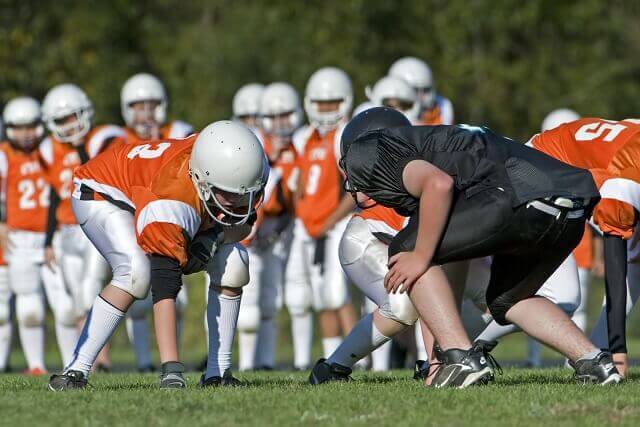
Free Consultation(203) 447-0000

Free Consultation(203) 447-0000

Concussion researchers have been studying head motion during high school football practice and the game strikes with exciting results. Once the study completes, they may have the insight needed to prevent further cases of concussion-related brain disorders from football.
The scientific research team, headed by Stanford University’s School of Medicine, examined three Bay Area high school football teams. The study launched in September 2018. The team’s principal researchers, David Camarillo (Ph.D.) and Gerald Grant (MD), are using special mouthguards that specifically measure the motion of head impacts during hits in-game and during practices. Researchers hope that these devices will provide them with insight so that they can better identify when and where concussions happen on the field.
The three schools involved include Menlo School and Sacred Heart Preparatory from Atherton, and Archbishop Mitty High School in San Jose. More than 100 players are enlisted in the study, and all will participate during the first year.
Camarillo’s research team had previously studied concussions at Stanford University athletes along with NFL players, but they have not done much research regarding high school and younger players.
Their study will be the first in children where they measure full motion and rotation of the head when impacted in-game. Camarillo feels it is vital for researchers to expand their knowledge for high school and younger-level players because most athletes get their start in these leagues.
Evidence already suggests that repeated head trauma early on increases the likelihood a player will develop Chronic Traumatic Encephalopathy (CTE) later. Therefore, measuring the impact and trauma applied can help possibly reduce the risks for those who want to start their football career at a younger age.
Right now, high school and children’s football leagues account for approximately four million players in the country, says Camarillo.
Therefore, it is imperative that researchers focus on these younger leagues to understand how concussions occur in one player but not the next. With the data they collect during preseason and game season, they hope that they can identify the risk factors.
These are not the ordinary mouthguards you pick up at a sporting goods store. Instead, the research team uses special units that will send back neurocognitive data, which they can use to establish a baseline for comparing neurocognitive data after a player suffers a suspected injury.
While practicing and during games, players wear these mouthguards that are equipped with unique sensors. Sensors measure motion in three directions:
They also measure three types of rotational acceleration, including pitch, yaw, and roll.
Researchers also intend to film the games and practices so that they can confirm the data retrieved from the devices, assess collisions, and estimate player speeds at the time of the impact. Player eye-tracking data will be collected to look for erratic eye motions immediately after a head impact, which may indicate a severe concussion.
The goal of the study is to highlight the type of collision that increases the chances of a concussion and help coaches better evaluate their players who are at risk for head trauma. Right now, coaches only watch collisions from the sidelines, but they have no way of accurately sensing the trauma their player’s brain has encountered post-hit. This study aims to improve diagnosis because, as of right now, coaches cannot detect brain injuries and have no way of accurately predicting whether a player’s brain suffered trauma based on a hit they took on the field.
Furthermore, the research team wants to see factors that influence injuries. They theorize that what looks dangerous could produce accelerations that are not dangerous. This means that a hit may seem “scary,” but does not result in injury for the player.
Regardless, Camarillo and his team recognize that, without the proper data, coaches would have to remove players from the field for any hit – whether the player is injured or not.
By knowing which hits are dangerous, players and coaches can also work toward creating methods for avoiding those collisions – hopefully decreasing the number of TBIs football players experience each year.
Coaches could eventually teach their athletes how to play football safely, leagues could create universal rules to prevent head trauma, and the sport could still be one that people enjoy without the risk of long-term injury.
The Stanford study plans to continue through the 2018 season and into the 2019 season.
Philanthropists fund research as part of the Taube Stanford Concussion Collaborative and the Stanford’s Child Health Research Institute.
Concussion research in sports has one primary goal: to reduce the number of Chronic Traumatic Encephalopathy (CTE) diagnoses for players. Several research studies have already released their findings, and they are working hard to find how concussions and repeated strikes to the head can lead to deadly conditions – especially CTE. Chronic Traumatic Encephalopathy is a degenerative brain disorder that can become life-threatening. Unfortunately, once CTE starts, it cannot be stopped or cured. Instead, physicians can only manage the symptoms that come from it. Eventually, it will lead to death.
More so, CTE is often misdiagnosed as other cognitive disorders such as dementia or Alzheimer’s. There is no definitive test for CTE as of yet, and the only way to accurately diagnose CTE is through an autopsy.
One finding from the Centers for Disease Control and Prevention (CDC) found that the number of annually reported concussions is well underestimated. The study, which looked at high school students currently playing football, found that the anonymously reported numbers did not reflect actual records over the past year.
The CDC study found:
One important takeaway from the CDC study is that players and parents alike are unaware of the symptoms of a concussion. And in some cases, coaches were unable to identify risk factors.
Parents and players are the first lines of defense. While there is a worry that a player will lose playing time that might affect college team acceptance, no one should ignore the signs of a concussion.
Common symptoms of a concussion include:
Smaller children may not exhibit the same symptoms. If your child plays in a little league, they could suffer a TBI even in a minor tackle incident. In these cases, they may only be irritable, tired, or have a change in their eating patterns.
Every school should have the ABCs in place for head trauma during sports:
Concussions, even if they are minor, are serious. Brain trauma, especially repeated incidents, can lead to CTE. A concussion does not require a loss of consciousness to be serious either, and receiving medical attention immediately could save a player’s life.
The best thing parents and players can do is to report their concussion. This ensures proper data for schools, and it ensures that injured players are not allowed to continue playing following head trauma.
Furthermore, seeking medical treatment immediately after the accident is essential. Even if the player feels fine, an emergency room physician can diagnose a concussion.
Most of the time, concussions only require rest and can be managed at home. However, a minor injury could result in something more serious, such as brain bleeding. Therefore, having a proper diagnosis is critical.
When leagues, schools, and professional organizations allow players to continue playing in a contact sport after a traumatic brain injury, they are legally liable for the long-term damage they cause. Whether it is in the NFL or a local high school football league, players must be protected from the brain degeneration that follows repeated head trauma.
If you are a player suffering from cognitive conditions as a result of your playing time, speak with an attorney that has experience in concussion cases. The advocates at Berkowitz Hanna have extensive knowledge regarding NFL concussion cases. We can help answer your questions and start the claim process so that you can retrieve the compensation you need for medical costs, inability to work, or long-term disability.
Contact Berkowitz Hanna today to schedule a no-obligation case evaluation. Call 203-487-5667 or contact us online to get started.
Berkowitz Hanna
